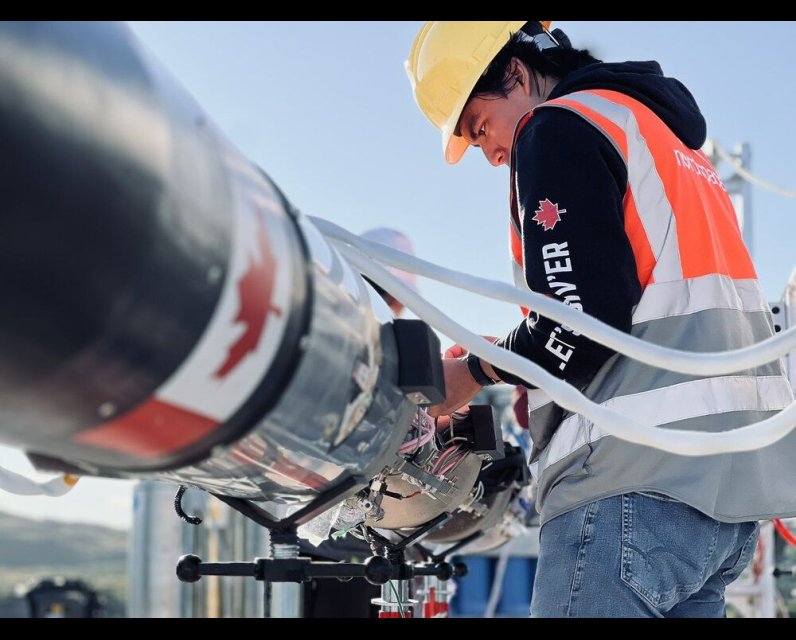After delays due to flames and a boat, Canada to make third try to launch a rocket to space

The first commercial rocket to blast off from Canadian soil doesn’t look like much.
Less than five metres tall — not even as tall as a two-storey house — the rocket, dubbed Taiga by its Canadian makers at Nordspace, will lift off from a scrubby corner of coastal Newfoundland, just outside the small town of St. Lawrence, about 350 km southwest of St. John’s. Its maiden voyage is expected to last about a minute, and it won’t even reach orbit.
Canadian astronaut Chris Hadfield calls that a good start.
“I’m really impressed with the way that Nordspace is going about their business,” Hadfield said in an interview with National Post. “Not just building rockets, but also building a launch centre, a launch site, and working with municipal, provincial and federal government, Transport Canada, all the regulatory bodies, as well as doing a really good job of developing the technology.”
Nordspace’s first launch attempt was at the end of August. It was delayed at first by the close passage of Hurricane Erin, and then by a misfire detection mechanism that triggered prematurely and put the rocket into a safe state just before it was to lift off. Nordspace then had to obtain a new launch licence from Transport Canada.
“We are pleased to have arrived at this absolute final point which is difficult to test precisely, even with static fires, until the rocket is actually flown,” the company said on its website, announcing the scrub of the first attempt. “We will be back very soon!”
The new launch window began on Sept. 20 and opens daily until Sept. 27 from 6:30 a.m. until noon and again from 3 p.m. to 7 p.m. local time. (Newfoundland’s time zone is 90 minutes ahead of Toronto and Montreal.)
High winds and clouds have been the main reasons for the delays this time. The rocket almost blasted off on Tuesday, “but was delayed for most of the launch window due to two fishing vessels entering the marine exclusion zone at different points, and a pad anomaly which caused a minor fire that required cleanup and inspection in collaboration with the local authorities and inspectors,” the company said on its website.
Hadfield, who has been to space three times, including a stint as commander of the International Space Station, has more than a casual interest in Nordspace’s launch. He helped found a technology incubator company called the Creative Destruction Lab, which in turn helped Canadian entrepreneur Rahul Goel found the Markham, Ont.-based Nordspace , just three years ago.
Hadfield points out that space travel is a massively difficult endeavour, and Nordspace’s three years from start-up to nascent launch is something of which to be proud.
“It’s good to start small and build up,” he said. “If you look at perhaps the world’s most famous private launch company right now, which is SpaceX, they were founded a little under 25 years ago, and it took them … five years, maybe six years, to launch their first rocket.”
Point taken. SpaceX was founded in 2002, and its first Falcon 1 rocket reached orbit in 2008 — after three failed attempts to launch.
“When they successfully launched their first rocket, they still had all sorts of teething troubles,” Hadfield noted. “But they now dominate the world. In the United States, the National Reconnaissance Office and the U.S. Air Force and U.S. Space Command all regularly launch their extremely high net worth payloads on SpaceX.”
He added: “And we launch human beings on SpaceX. We trust their rockets now enough to take people to the space station and back, and the cost is low enough that some private citizens have bought flights flying SpaceX vehicles.”
The launch, when it happens, can be watched live here.
The launch itself couldn’t be more Canadian. The Taiga is named after a type of coniferous forest found at high northern latitudes, including the region of Newfoundland where the launch will take place.
The inaugural launch has been dubbed “Getting Screeched In,” a reference to the tradition of making those “from away” into honorary Newfoundlanders by having them kiss a cod and take a shot of local rum, known as screech. Taiga’s rocket fuel, a mix of kerosene and liquid oxygen, will be somewhat stronger stuff.
And of particular interest to Hadfield is the company’s 3D printed rocket engine, which has been named the Hadfield. Nordspace has two other rocket engines, Garneau and Bondar, named after Marc Garneau, the first Canadian to go to space, and Roberta Bondar , Canada’s first female astronaut and the first neurologist in space.
“We believe that it is critical for a Canadian launch capability to be supported by Canadian designed and manufactured rockets, launching from Canadian soil, by a 100% Canadian owned company,” Nordspace said on its website. “We welcome you to join us as we open this new frontier for Canada.”
Hadfield is happy to have his name on the engine that will take Taiga to the edge of space.
“When you invent something, you’re free to name it whatever you like,” he said. “But … the Hadfield engine is an immense compliment, and I’m very honoured that they would use my name for one of their rocket engines. That’s delightful. I hope it serves them well.”
Taiga is merely the first step in the company’s plans. If the sub-orbital flight — with a partially fuelled rocket, and a flight time of only about 60 seconds — goes well, the next step would be to fly the Tundra, named for the treeless region to the north of taiga areas in the Arctic.
The Tundra would be more than four times as tall as the Taiga, at about 22 metres, with two stages and multiple Hadfield engines. “Our goal is to fly Tundra for the first time as early as 2027,” the company said on its website.
“This historic launch from Canadian soil of our Taiga sub-orbital rocket, powered by our 3D printed Hadfield engines, will represent a massive leap forward for Canadian sovereignty, prosperity, and security and for assured access to space,” it added.
Hadfield has thoughts on that too. He noted that, as the geopolitical pendulum swings form internationalism to nationalism, “it becomes more important to be able to do things on our own, and not just through international co-operation, like we’ve been doing since Canada’s first satellite in space in 1962 with Alouette, which we co-operated with the U.S. to have one of their rockets launching.”
He added: “For Canada to stay sovereign and be competitive on the world stage, we need to shift what we’re doing and not just rely on the expertise and capability of others for some things, and one of those things is rocket launch. So I think this is a good, bold, necessary move in the right direction for Canada.”
Our website is the place for the latest breaking news, exclusive scoops, longreads and provocative commentary. Please bookmark nationalpost.com and sign up for our daily newsletter, Posted, here.



Comments
Be the first to comment